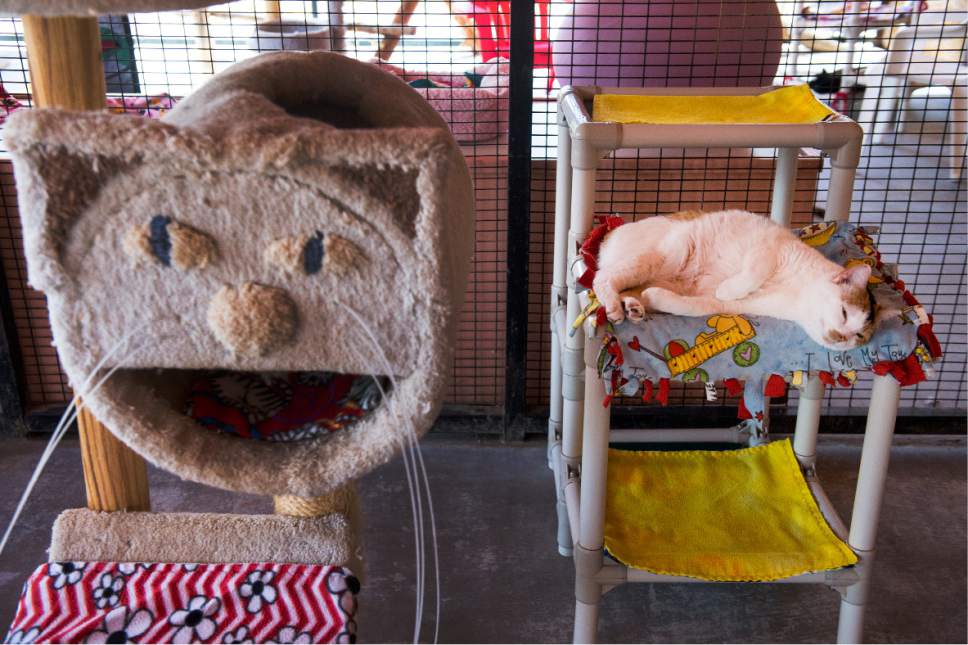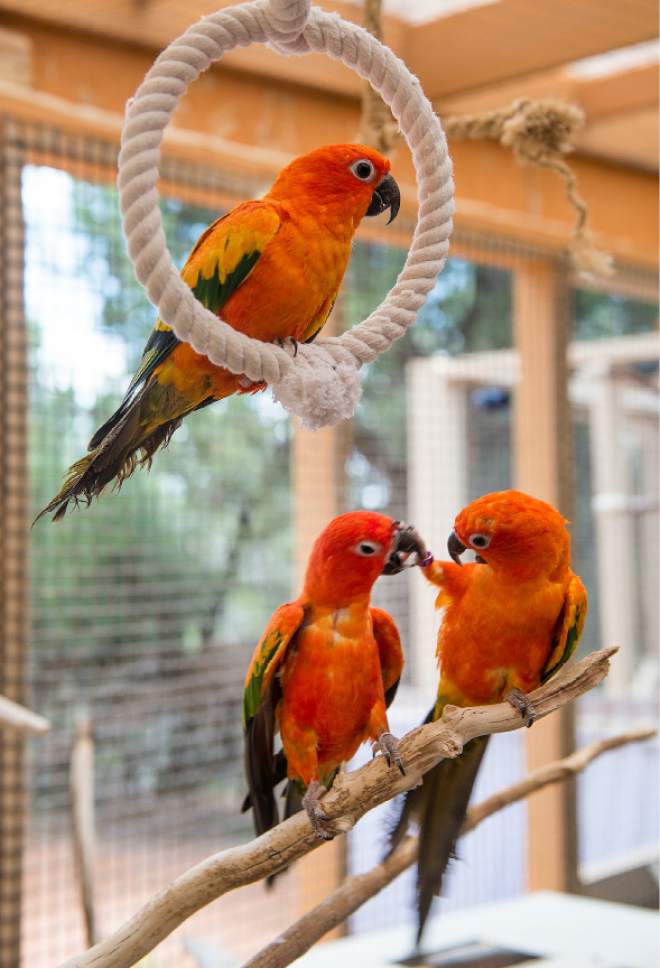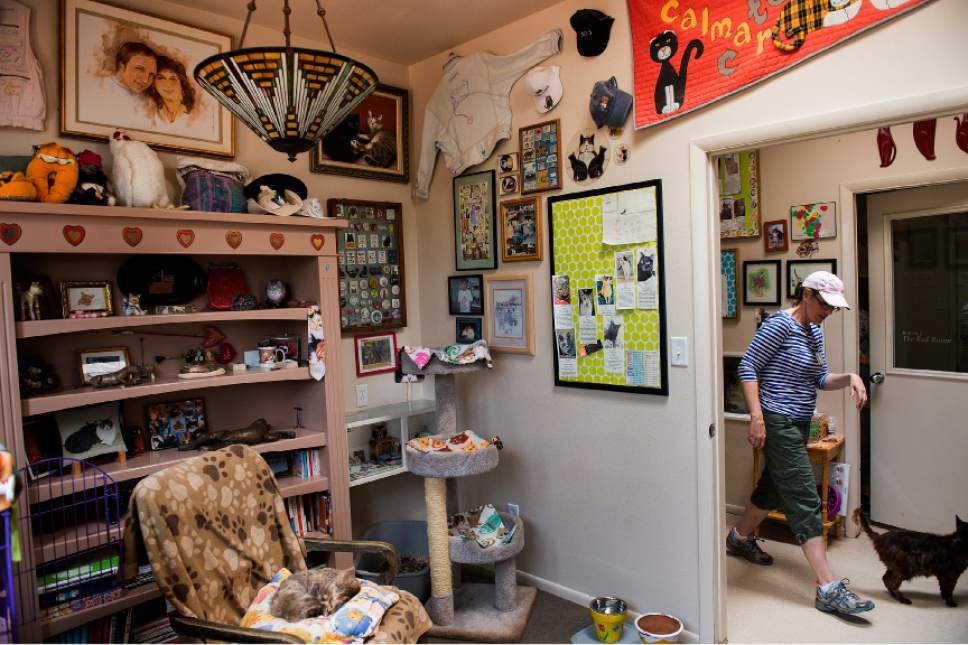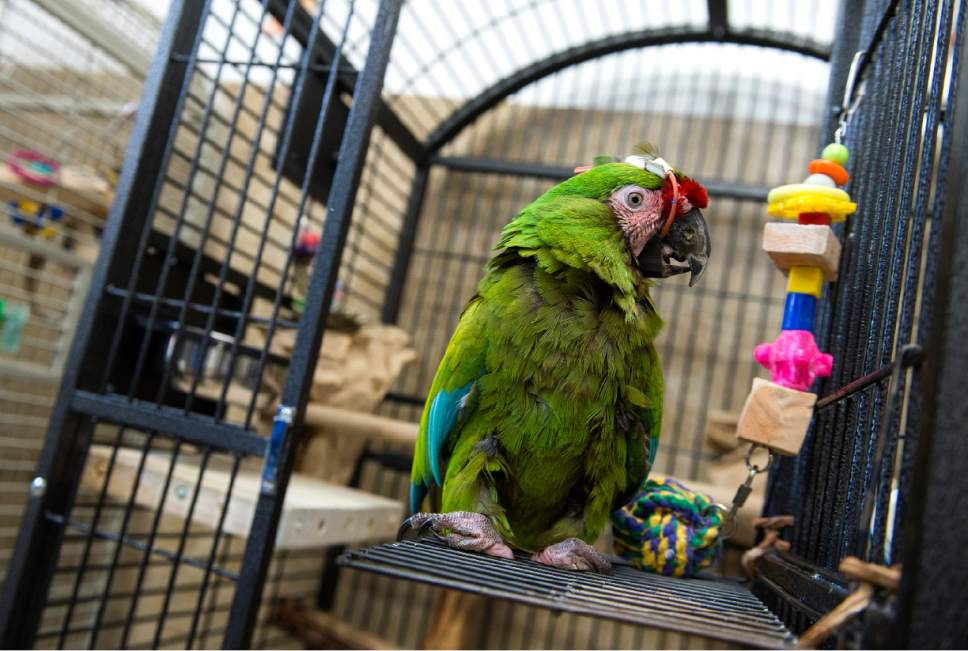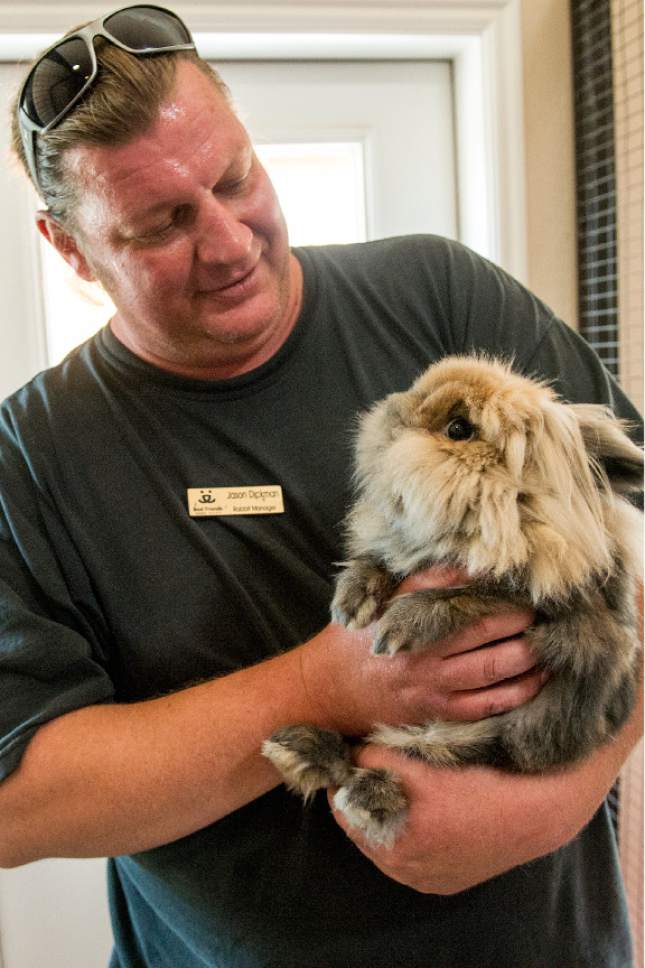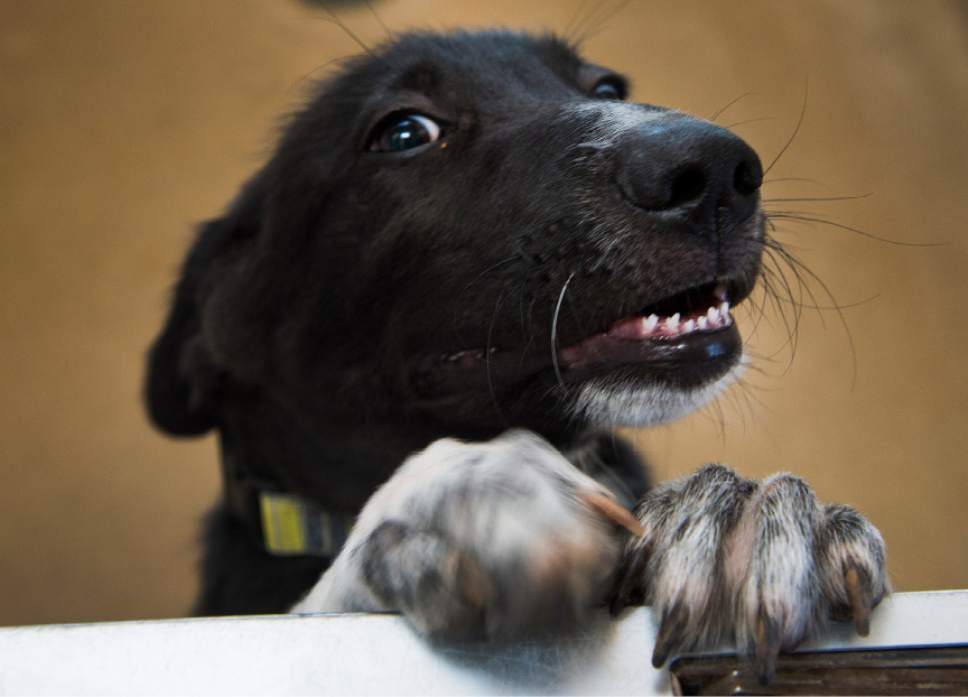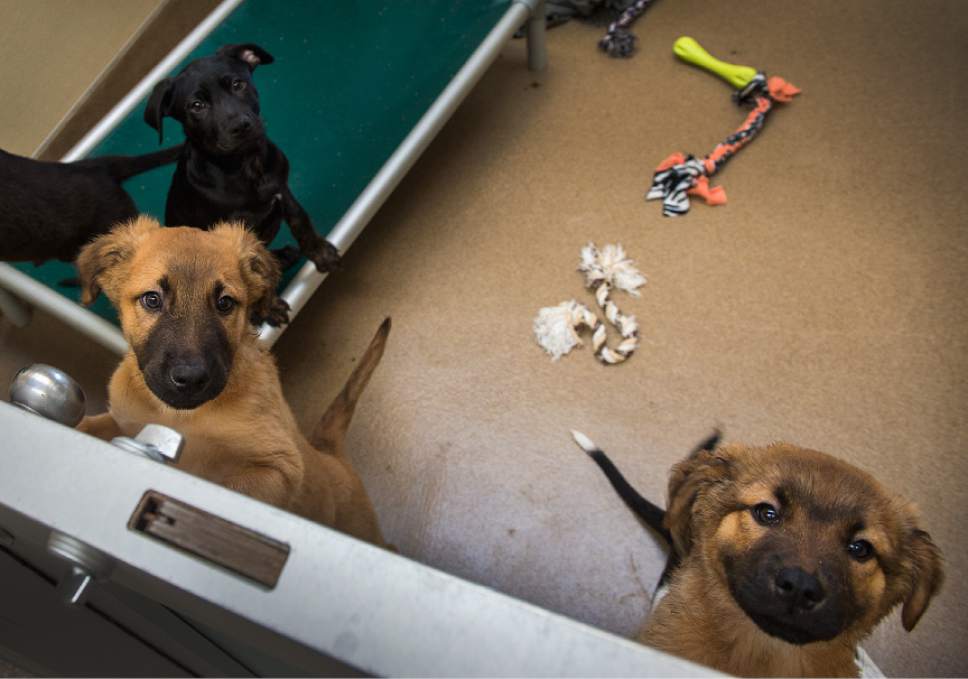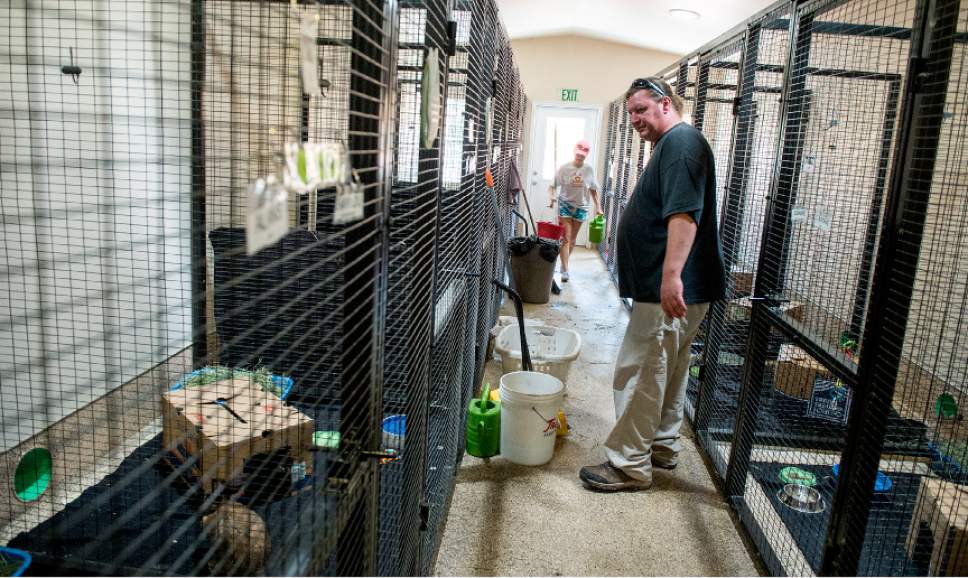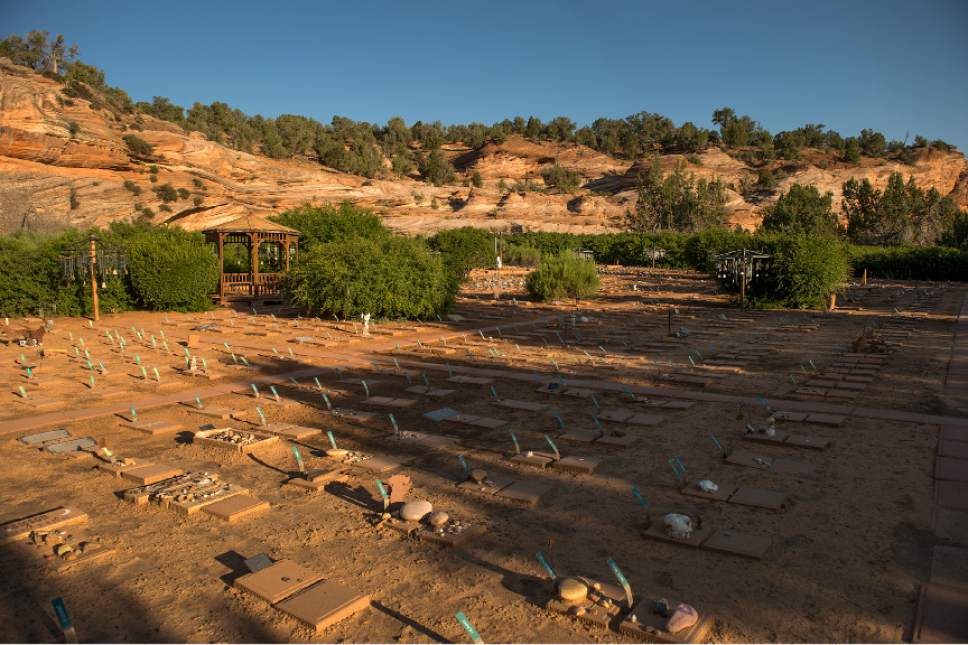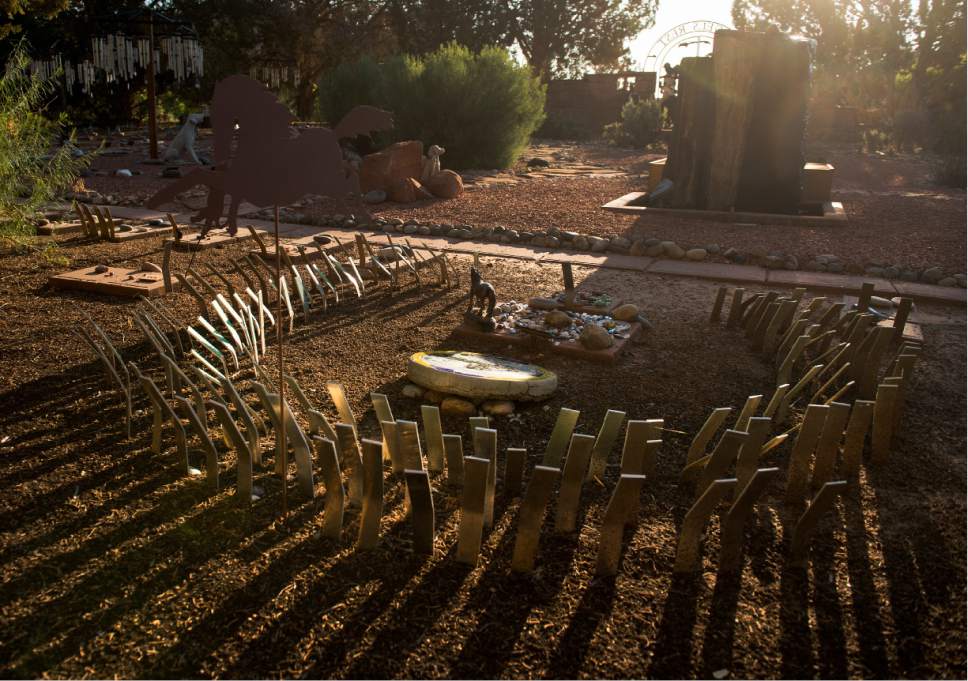This is an archived article that was published on sltrib.com in 2017, and information in the article may be outdated. It is provided only for personal research purposes and may not be reprinted.
Kanab • When you visit the Best Friends Animal Sanctuary, you'll want to bring along a thesaurus. You'll need a few synonyms for "spectacular."
The staff there does spectacular work on behalf of 1,600-1,700 animals — a number that fluctuates as the animals are adopted out and replaced by others in need.
And they're doing this work in the midst of spectacular scenery. Angel Canyon is absolutely breathtaking, with towering red rock and vistas that look they were created for Hollywood movies.
If you're familiar with southern Utah, you'll be mesmerized by the beauty. If it's your first visit to the area, you'll be astonished. It's hard to comprehend the scope and the scenery until you're there.
"Nobody can," said co-founder Silva Battista. "Not our big donors. For years and years, we've made videos and we tell them all about it. And then they get up here and they say, 'Well, why didn't you tell me? Why didn't you tell me how beautiful it is?'
"We consider it to be a real partner in what we do."
What Best Friends does is save thousands of animals every year. It is the nation's largest no-kill sanctuary, encompassing about 3,700 acres about 5 miles outside Kanab.
There are usually 400-450 dogs and more than 500 cats at the sanctuary, with large populations of animals and human staffers living or working in different areas.
But the breadth of the work being done there is equally amazing. Yes, Best Friends rescues dogs and cats, but it also rescues horses and donkeys and goats and pigs and birds and rabbits and guinea pigs and wildlife.
And no pet lover can help but be moved by a visit to the Best Friends cemetery, Angels Rest. The 3-acre location is beautiful and sad — the site of some 5,000 "placements" of dogs, cats, pigs, guinea pigs, birds and more.
There's a second site on a bluff above the original cemetery, which is equally stunning. There are beautiful metal gates, wind chimes hanging in the trees, and a meditation labyrinth that leads to the edge of the cliff.
It wouldn't be fair to call Best Friends Animal Sanctuary one of Utah's best-kept secrets, because there's absolutely nothing secret about it. The folks there want you to visit. It's open to the public, and they provide free tours seven days a week, 364 days a year. (Every day but Christmas.)
And they don't want you to just visit, they want you to stay a while. There are, indeed, place to stay at the sanctuary. And if you're visiting, why not volunteer?
They love volunteers at Best Friends. There's a lot to do, and they appreciate any help they can get. You might muck out some stalls, put together bird toys or help socialize puppies.
And you might just catch the volunteer fever if you take one of the tours.
A few weeks ago, I visited the sanctuary for the first time. I intended to just take a couple of the regular tours, but ended up spending much of the day being shown around by Faith Maloney, who is not just one of the co-founders but one of the best tour guides ever. She's been there since the beginning, after all, and knows pretty much everything and everyone involved.
Here are 40 things I learned about the Best Friends Animal Sanctuary:
1. Best Friends purchased 3,000 acres in Angels Canyon nearly 30 years ago. It paid $300 an acre. Today, land in the area sells for about $10,000 an acre.
"So that was a good buy," Maloney said with a laugh.
The organization has since purchased another 700 acres, "and that cost quite a bit more," she said.
2. Only about 300 acres are in use. "Even saying 300 acres doesn't convey it, because it's a bit here and bit there and a bit there," Maloney said. "There's so much land here."
And Best Friends has leased another 17,000 acres from the U.S. government — land that is left wild.
3. A lot of people work at the sanctuary. There's a paid staff of more than 400 — about half of them work in animal care; the other half are support staff.
4. Horses benefit from electro-pulse therapy. On the day I visited, two little horses who survived serious neglect were rather patiently undergoing treatment.
The former owners of Salt and Pepper didn't understand the care horses require, and it reached the point where their hooves "didn't even look like real hooves," said veterinarian Tim Rogers.
According to Rogers, the kind of care the horses received would cost somewhere in the neighborhood of $200 a week, "which most people would not do. So they're getting something I don't think they would've gotten anywhere else."
5. Best Friends has its own horse shows. If you visit the sanctuary on Tuesdays or Fridays, you can attend a demonstration of the Parelli method —"a relationship form of horse training," Maloney said. "It's miraculous."
6. Pigs need pig friends. The animals in Piggy Paradise get plenty to eat, lots of land to roam, heated and cooled houses, and companionship.
"They really do not do well alone," Maloney said. "They obviously manage, but we can't give them what another pig can. We can be the one for a single dog or a single cat, but not a single pig. And from our experience, they often become aggressive if they don't have another pig to play with."
7. Pot-bellied pigs grow to be 150-200 pounds. They aren't full grown until they are 4 years old. And the females can give birth when they're only 4 months old.
"So a baby is having babies at 4 months, Maloney said. "And when you ask how big the piglets will get, these infamous breeders are saying, 'Well, look at the parents.'
"There's nothing cuter than a piglet. But nobody tells you that that is actually a good, normal-sized pig," Maloney said, pointing to the full-grown porkers.
8. You have to look out for wild turkeys. There are hordes … er, uh, flocks of wild turkeys at Best Friends, and they seem oblivious to vehicles.
"We have to tell people when they come here that they're not going to move out of your way," Maloney said. "They're bold as brass."
9. There's a movie barn at the sanctuary. In the middle of a gorgeous, pastoral scene — a field against the backdrop of a cliff — there's a weathered barn that was built there for the filming of the 1971 movie "One Little Indian," which starred Jame Garner, Vera Miles and Jodie Foster.
There was also a movie house, but that was given away because "we didn't have any need for it. But a movie-set barn, we thought, was pretty neat," Maloney said. "I can't tell you how many people stop here and take a photo."
10. Jewish cat owners started a trend at Angels Rest. They were the first to place small rocks on headstones, and now painted rocks are on almost every grave.
One volunteer from Phoenix not only paints the stones, but travels to Best Friends twice a year to touch up where they've become worn in the weather.
"She used to just go out and find river rocks," Maloney said. "Apparently, now she orders them."
11. There's a Hurricane Katrina memorial at Angels Rest. Best Friends staff and volunteers spent about nine months in Louisiana and Mississippi after the 2005 storm.
"We had roughly 6,000 animals go through our care during that time," Maloney said. "Including boas and tarantulas — things we had no experience with. Seriously, all manner of pets got displaced at that time."
12. Every animal is neutered before it is adopted. On this particular day, there are only 11 puppies at Best Friends — and nine of them are being spayed or neutered.
"We spay and neuter at 8 weeks, 2 pounds," Maloney said. "We do not trust people."
Some rescues send people home with certificates for free spay/neuter for their puppies or kittens. Not Best Friends.
"People forget," Maloney said. "Even if they've paid money — even if they've paid a huge deposit — they still forget."
13. The Dog Town sign will make you smile. It reads "Dog Town Heights: A Gated Community."
14. The dogs live in eight-sided buildings. They're modeled after structures Maloney saw at a dog rescue in California.
"We just knew we didn't want to reproduce the traditional humane society with corridors and concrete," she said.
15. There's a doggie fitness center. Among the options — underwater training for rehab, arthritis and recovery from surgery.
16. Some dogs can't be housed with other dogs. Although some of those who can't live with other canines can have "playdates" with other dogs.
"Our original plan was group housing," Maloney said. "I had 10 in my bedroom at one point, so I thought, 'What's the big deal?' But now I know better."
17. A lot of puppies cycle through the sanctuary. "We have, generally, 300 or more puppies that come through in a year," said staffer Danielle Smith, displaying the "fun box" — which is filled with hundreds of pictures of puppies who have found homes.
"This is 2016's adoptions, and that's not even all of them," Smith said. "Some puppies leave so fast they don't get a picture taken."
Maloney recalled one litter of Shih Tzu puppies that "were all spoken for using social media before they ever hit this building. Literally, every single one."
18. Volunteers won't want to adopt every puppy. "Well, you say that. And then you come in and there's poop above the windows," Smith said. "And you're like, 'Nope.' "
But then … Smith has four dogs at home and is fostering another.
"Puppies, for me, are a lot easier, because they fly out of here," Smith said. "It's the ones that stay. The ones that, for whatever reason, aren't getting adopted, are hard."
19. Dog collars are color-coded. The collars instantly provide information to staff and volunteers: Red collar — staff only; purple collar — no one under 18; green collar — family friendly.
20. All dogs get a lot of love. Dogs with issues that require they remain at the sanctuary permanently aren't just locked in a cage.
"They actually get a lot of attention from the staff," Maloney said. "They'll go out on walks on the trails. They don't have to live inside all the time."
21. There are 11 buildings in Cat World. And that provides options other than just housing all the kitties in large groups.
"A lot of cats don't like other cats. Then you put them in a big group and they start spraying. Peeing inappropriately. Biting you. Clawing you. And just doing awfully bad things," Maloney said. "This was limiting adoptions considerably.
"So having this [individual and small-group] building has been enormously helpful. The first year it was open, we placed 100 cats."
22. Kittens are quarantined when they arrive. "It literally is like a medical unit in there. It's like dealing with someone in ICU," Maloney said.
Humans have to wear gowns and masks.
23. There are strollers for cats. Some cats can go out with prospective adopters on harnesses and leashes.
"And if they can't, then the cats go out with strollers," Maloney said. "It's great to see a family with little kids pushing a stroller with cats in it."
24. You should be careful if a cat "plan" includes the phrase "Watch for overstimulation." Behaviorists develop individualized plans for the cats. And that phrase "means that they attack you. We don't put that in, though," Maloney said with a laugh.
There are steps to modify that behavior.
25. There is an ongoing debate about rafters in Cat World. Some of the shelters have open roofs with exposed rafters, and the cats climb up on them. Others have ceilings that keep the cats out of the rafters.
"Some people have very strong opinions about why one is better," Maloney said.
26. There is a feline leukemia-positive building for those cats. Feline leukemia is a retrovirus analogous to HIV in humans.
27. 2016 was a great year for goat adoptions. "We work with other sanctuaries around the country, but we had had a very, very good year last year for goat adoptions," Maloney said. "It was, like, bumper goat adoptions."
28. If an adoption doesn't work out, you can return the animal to the sanctuary. "We're 100 percent guaranteed adoptions," Maloney said. "If an incident occurs at any time, the dog comes back. Or the cat. And we've taken animals that have been out there over 10, 12 years."
They accept returns without judgment. Even returned horses.
"We get a fair amount that come back to us, even after a good prep," Maloney said. "But then life hits. Something happens. Losing jobs. Move out of state."
29. Best Friends started naming buildings after donors — eventually. "We were very set for a long time on saying 'only animal names,' " Maloney said. "Then a $500,000 matching grant came from Delores and Homer [Harris], and we named [dog shelters] after them. We felt we were covered because we had dogs that were named Delores and Homer.
"Now we shamelessly call things after people."
30. Best Friends is a coast-to-coast organization. It has offices in Los Angeles, New York, Atlanta and Salt Lake City. And it partners with more than 1,800 other no-kill organizations.
31. The main clinic would put a lot of human hospitals to shame. In addition to smaller clinics in various parts of the sanctuary, there's the main medical facility — a 3-year-old, 13,000-square-foot, geothermally heated, $5 million-plus clinic that's sleek, clean and high-tech.
Besides all the spaying and neutering, there is state-of-the-art treatment for everything from bad teeth to cancer. There are chiropractors and acupuncturists in addition to vets trained as animal oncologists.
32. The medical facilities at Best Friends have come a long way. "The original clinic was an old Airstream trailer, and the vet we were working with had been given it in payment for a bill," Maloney said. "And he gave it to us."
33. You can volunteer for a day or for a lifetime. "People move to Kanab so they can come volunteer. So we like to honor that by giving them more to do than just wiping off counters," Maloney said. "If we have good, long-term volunteers, we put them through training programs. So we have a whole bunch now that do physical therapy."
34. Rabbit care requires a lot of training. Bunnies are not as easy to care for as you might think. Best Friends does online training for people who want to adopt a dog or a cat; you have to actually go to the sanctuary for "a series of trainings" to adopt a rabbit.
"Bunnies are bottom heavy," Maloney said. "If a child picks up a cat, the cat will hang. If the child does that to bunny rabbit, he's broken his back. So the education required to adopt a bunny is huge."
35. Bunnies poop a lot. "Each bunny, it's estimated, poops 350 times a day," Maloney said.
36. Birds choose whom they go home with. "If someone sees a bird on the Best Friends website and goes to the sanctuary hoping to adopt it, we say, 'Well, we'll see if he likes you,' " Maloney said. "The bird chooses you. You do not choose the bird."
37. The sanctuary rehabs a lot of wild birds of prey. Somewhere in the neighborhood of 300 hawks and eagles a year.
Best Friends has a hawk that's been part of its educational program since 2001, but it does not house all the raptors that cannot be returned to the wild.
"If we kept every bird that came in and couldn't be released, the whole place would be covered with them," Maloney said.
38. Almost all the animals have indoor-outdoor facilities. Even the bunnies and the guinea pigs.
39. The vegetarian/vegan lunch buffet is delicious. And the view from the dining room in the welcome center is stunning.
40. There are no fish in the fish pond next to the Welcome Center. The fish are being kept in a big pool in the clinic.
"One of our veterinarians … noticed that they weren't doing well down there," Maloney said. "She said, 'The pond was designed well for plants, but not for fish.' So until that pond is redone, the koi will be living up here."
spierce@sltrib.com
Twitter: @ScottDPierce
—
Best Friends facts
Tour Best Friends
The sanctuary offers a two-hour Grand Sanctuary Tour four times a day, seven days a week, 364 day a year. (Every day but Christmas.) After a brief video introduction at the Welcome Center, visitors will climb in a van and visit cats and dogs and pigs and horses and parrots and more.
Make a reservation at bestfriends.org.
There are also a variety of specialty tours:
Dogtown (Monday-Friday, 8:30-10:30 a.m.)
Behind the Scenes of Old Dogtown, for adults 18 and older (Sunday, Monday and Tuesday, 1:30-3 p.m.)
Cat World Headquarters, for ages 12 and older (Wednesday-Friday, 1:30-2:45 p.m.)
Horse Haven and Marshall's Piggy Paradise (Mondays and Wednesdays, 9-9:45 a.m.)
Horse Haven Parelli Horsemanship Demo (Tuesdays and Fridays, 10:30-noon)
Parrot Garden (7 days a week, 11-11:45 a.m.)
Bunny House (7 days a week, 2-2:45 p.m.)
Wild Friends (7 days a week, 10:15-11 a.m.)
There's a quickie, 45-minute tour, but you don't get out of the van or meet any animals. Odds are it will just persuade you to schedule a longer tour.
There are guided hikes of Angel Canyon on Sundays and Thursdays from 10:30-11:30 a.m. The hike is of moderate difficulty; children and leashed dogs are welcome.
Stay at Best Friends
You, your children and your pets — of course — can stay at the sanctuary.
Cottages accommodate up to six guests and three pets ($120-$140 a night March-November; $95 a night December-February).
Cabins accommodate two guest and two pets ($75-$95 a night March-November; $60 a night December-February).
There are also two RV sites ($30-$50 a night March 15-Oct. 31; closed Nov. 1-March 14).
For reservations, go to bestfriends.checkfront.com/reserve/, call 435-644-2001 ext. 4826, or email cottages@bestfriends.org.
Volunteer at Best Friends
To make arrangements to volunteer, go to volunteers.bestfriends.org or contact that sanctuary's volunteer department by emailing volunteers@bestfriends.org or calling 435-644-2001, ext. 4119.
Directions to Best Friends
The sanctuary is about 5 miles north of Kanab on U.S. 89. The entrance is on the east side of the highway, between the Mile 69 and Mile 70 markers. Turn in and drive about 1.5 miles to the Welcome Center.
Best Friends is open 8 a.m.-5 p.m. seven days a week, 364 days a year. (Closed on Christmas.)


